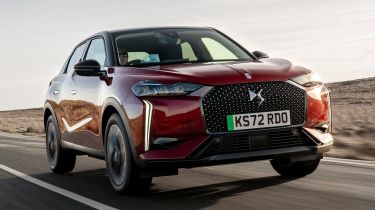New DS 3 E-Tense 2023 review
The electric DS 3 E-Tense SUV gets a useful increase in range, but is still very pricey

Verdict
There are lots of things to like about the new DS 3. Its composed and well judged electric powertrain makes it easy and reassuring to drive, with a decent real-world range, while the interior flair is more interesting than many other EVs in its class. But put simply, there’s just no getting around the fact that it’s an expensive compact SUV. At more than £40k for this plush Opera version, we’d go for a model a bit lower down the food chain, although these are still expensive.
Don’t let the name fool you: this isn’t a new supermini from DS to replace the popular DS 3 of old. It’s an updated, and indeed renamed version of the car formerly known as the DS 3 Crossback, the smallest SUV in the French brand’s line-up.
The DS 3 range now consists of two petrol options and this updated E-Tense all-electric version. It’s in the EV that you’ll discover the biggest changes. It looks different thanks to a mid-life nip and tuck, and should also deliver a better day-to-day ownership experience, thanks to an updated electric powertrain that offers more claimed range.
Although the SUV-inspired name is no longer, the DS 3 carries over plenty of the chunky crossover design cues that defined the previous version of the car. It still rides slightly higher than a supermini and has an upright shape, rounded off by black plastic-clad wheelarches (home to wheels up to 18 inches in size) and side skirts.
Used - available now
A new, slightly wider grille is flanked by redesigned headlights, now with LED tech and an automatic main-beam function as standard. Updated LED daytime running lights echo the new look worn by the DS 4 and facelifted DS 7. A more aerodynamic lower bumper section has been introduced, while the tailgate has ‘DS Automobiles’ in a gloss-black strip that runs from the tail-lights. There’s a redesigned rear spoiler, too.
On the move you’ll be hard-pressed to detect the important changes to the car’s all-electric powertrain. Small but subtle recalibrations result in a larger battery than before, an extra 4kWh of capacity taking the pack’s gross size to 54kWh (51kWh is usable). This is joined by a more powerful single electric motor (now rated at 154bhp) driving the front axle. The end result is a car with a 250-mile range on the WLTP cycle, up from around 200 miles in the old model.
Despite the range and usability of the DS 3 increasing, the driving experience remains as it was. It doesn’t leap forward with an instant shove like many electric cars; the throttle map feels natural and results in similar off-the-line progression to any petrol version of the DS 3 with an automatic transmission.
It’s still nimble around town, though, and has enough pace and torque to settle nicely at a motorway cruise silently and comfortably. Little wind and road noise penetrates the cabin, making it quite serene.
A sports car it is not, so the DS 3’s predictably low tolerance of being driven enthusiastically, even in Sport mode and with its slightly firm suspension set-up, isn’t really anything to be too concerned about.
If you’re looking for something a bit more left-field and alternative, the DS 3’s interior could be one of this car’s main draws. Material quality is pretty good; it does feel premium and the design, unchanged from the pre-facelift car, is certainly more expressive than some of the cost-cutting, minimalist approaches taken by rivals.
The 10.3-inch touchscreen runs the slick new DS IRIS infotainment software, with its improved organisation and graphics. Other interior changes include minor switchgear alterations on the steering wheel.
It’s all part of a vibrant cabin that looks unique alongside rivals, despite feeling a little small. Rear legroom is at a premium, while the ‘shark fin’-style detailing on the B-pillar restricts the view for those in the back. But the 352-litre boot is a good size.
The big sticking point remains the car’s price. Our Opera-spec model costs £42,700, and is a staggering £726 a month with a 10- per-cent deposit on a 37-month PCP deal. Entry-level Performance Line models are £658 a month on the same terms, but it’s a big monthly outlay for a small electric car.
| Model: | DS 3 E-Tense Opera 115kW |
| Price: | £42,700 |
| Powertrain: | 54kWh battery, 1x e-motor |
| Power/torque: | 154bhp/260Nm |
| Transmission: | Single-speed automatic, front-wheel drive |
| 0-62mph: | 9.0 seconds |
| Top speed: | 93mph |
| Range: | 250 miles (WLTP) |
| Charging: | 100kW (10-80% in 30 mins) |
| On sale: | Now |













